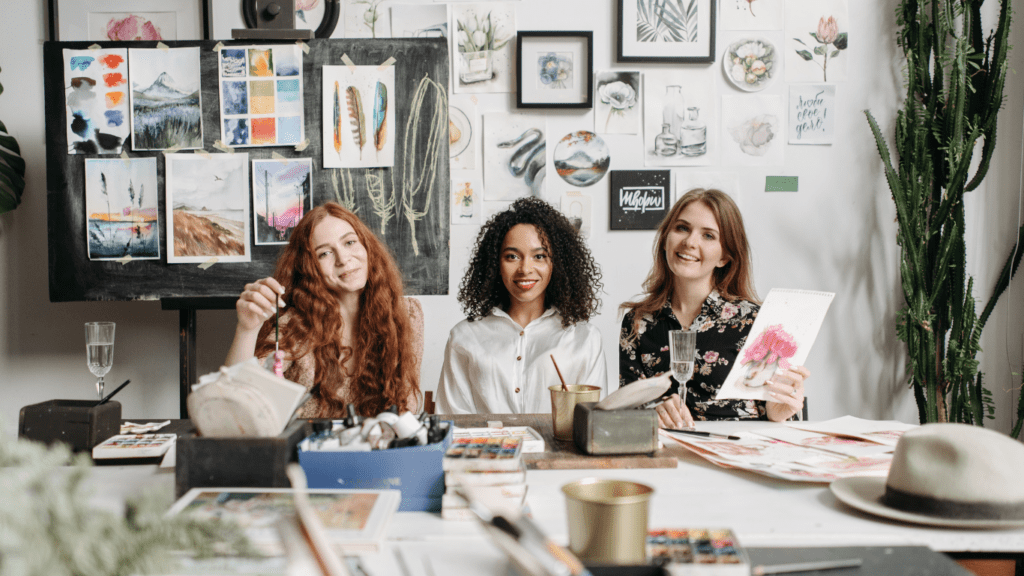Understanding the Value of Collaboration in Art
Collaboration in art enhances creativity and exposes artists to new perspectives. Sharing ideas with others often results in innovative artwork.
The Concept of Collective Creativity
Collective creativity involves multiple artists contributing their unique skills and ideas to a single project. Each artist brings distinct strengths; combining them can lead to unexpected and rich outcomes.
For example, a painter might work with a sculptor to create a multimedia piece neither could achieve alone. The synergy between collaborators often sparks new, uncharted creative territories.
Historical Examples of Successful Art Collaborations
- Art history offers numerous examples of fruitful collaborations.
- Andy Warhol and Jean-Michel Basquiat’s partnership in the 1980s produced groundbreaking works that melded Warhol’s pop art with Basquiat’s graffiti style.
- Another notable example is the collaboration between Picasso and Braque, who co-founded the Cubist movement by sharing and developing ideas.
- These partnerships highlight how collaborating with other artists can result in pioneering artistic achievements.
Key Benefits of Collaborating with Other Artists
Collaborating with other artists offers immense value by combining unique strengths and expanding horizons.
Pooling of Diverse Skills and Perspectives
Collaboration allows artists to pool diverse skills and perspectives. Each artist contributes unique techniques, enhancing the collective creative output.
For example, when painters and sculptors work together, they create multidimensional art that blends both mediums seamlessly. Similarly, combining a photographer’s eye with a painter’s brush leads to innovative visual narratives that neither could achieve alone. This diversity fosters creativity by opening avenues that might remain unexplored in solitary work.
Accelerated Learning and Skill Development
Artists benefit from accelerated learning and skill development through collaboration. When working alongside others, individuals learn new techniques and methods more quickly.
For instance, a digital artist might gain insights into traditional art forms, while a seasoned painter acquires modern digital skills. This knowledge exchange ensures a steep learning curve, significantly enhancing proficiency in various art forms. Collaborating also provides immediate feedback, which refines skills faster than working in isolation.
Increased Exposure and Network Expansion
Increased exposure and network expansion are significant benefits of artist collaboration. Joint projects attract a broader audience base, combining the followers of each collaborator.
This extended reach introduces the work to new demographics. Additionally, partnerships often lead to new opportunities, such as gallery shows or exhibitions, that wouldn’t be possible individually. An expanded network of fellow artists, critics, and patrons further bolsters one’s professional standing in the art community.
Challenges and Considerations in Artistic Collaboration

Collaborating with other artists presents both rewards and challenges. In this section, I’ll explore key considerations to manage effectively.
Navigating Creative Differences
Conflicting visions can arise in any artistic collaboration. Diverse backgrounds and styles enhance creativity but can also lead to disagreements. Clear communication ensures all voices are heard.
Establish priorities early to avoid conflicts. Regular meetings facilitate ongoing dialogue. Flexibility is essential to merge various ideas seamlessly. An example is Warhol and Basquiat, who navigated their starkly different styles by agreeing on thematic elements that unified their work.
Managing Collaborative Projects Efficiently
Organizing collaborative projects demands excellent project management skills. Define roles to ensure tasks align with each artist’s strengths. Create detailed timelines for each phase.
Tracking progress frequently keeps the project on schedule. Use collaborative tools like Trello or Asana for task management. For instance, during large-scale mural projects, assigning specific sections to each artist prevents overlap and confusion.
These considerations address common challenges in artistic collaborations, helping to create harmonious, productive partnerships.
Real-Life Success Stories of Artistic Collaborations
Real-life collaborations among artists have led to groundbreaking work and significant professional growth. The following case studies illustrate how diverse artistic fields benefit from such partnerships.
Case Studies from Various Art Forms
Music: Freddie Mercury and David Bowie
Freddie Mercury and David Bowie created the iconic song “Under Pressure” in 1981. Their collaboration resulted from an impromptu studio session, demonstrating how spontaneous interactions can lead to lasting artistic achievements.
This partnership merged Mercury’s dynamic vocal range with Bowie’s innovative style, producing a track that remains influential.
Visual Arts: Andy Warhol and Jean-Michel Basquiat
Andy Warhol and Jean-Michel Basquiat collaborated on a series of paintings in the 1980s. Their partnership blended Warhol’s pop art techniques with Basquiat’s graffiti-inspired style.
Despite initial skepticism about their compatibility, their works challenged conventional art boundaries and remain celebrated in art history.
- Film: Steven Spielberg and George Lucas
Steven Spielberg and George Lucas significantly impacted the film industry with their collaboration on “Indiana Jones”. Spielberg directed while Lucas produced and co-wrote. By combining Spielberg’s storytelling prowess with Lucas’s imagination, they created a highly successful and enduring film franchise.
- Literature: Neil Gaiman and Terry Pratchett
Authors Neil Gaiman and Terry Pratchett co-wrote “Good Omens,” blending their unique narrative styles. Published in 1990, the novel became a cult classic, showcasing how combining different literary voices can create a distinctive and compelling work. Their collaboration remains a testament to the power of shared creativity.
- Fashion: Alexander McQueen and Sarah Burton
Alexander McQueen and Sarah Burton revolutionized the fashion industry. McQueen’s visionary designs paired with Burton’s technical expertise resulted in iconic collections. After McQueen’s passing, Burton continued his legacy, proving the enduring influence of their collaboration on fashion.
These examples from music, visual arts, film, literature, and fashion, show how artistic collaborations foster innovation, merging diverse talents and perspectives to create influential and memorable work.

 Donemic Grantnurry, founder of the Avant Garde Artistry Hub, is a visionary at the intersection of art and technology. With a deep passion for innovation, Donemic has created a platform that not only informs artists about the latest tools and trends but also empowers them to transform their creative processes. His dedication to exploring the therapeutic potential of art has positioned Avant Garde Artistry Hub as a key resource for artists seeking to improve both their craft and well-being.
Beyond his work in art technology, Donemic is committed to helping artists build sustainable careers. Through insightful articles on marketing, business strategies, and art competitions, he provides emerging talents with the guidance they need to succeed in the competitive world of art. His work continues to inspire and support a global community of creatives who are passionate about blending art with modern technology.
Donemic Grantnurry, founder of the Avant Garde Artistry Hub, is a visionary at the intersection of art and technology. With a deep passion for innovation, Donemic has created a platform that not only informs artists about the latest tools and trends but also empowers them to transform their creative processes. His dedication to exploring the therapeutic potential of art has positioned Avant Garde Artistry Hub as a key resource for artists seeking to improve both their craft and well-being.
Beyond his work in art technology, Donemic is committed to helping artists build sustainable careers. Through insightful articles on marketing, business strategies, and art competitions, he provides emerging talents with the guidance they need to succeed in the competitive world of art. His work continues to inspire and support a global community of creatives who are passionate about blending art with modern technology.